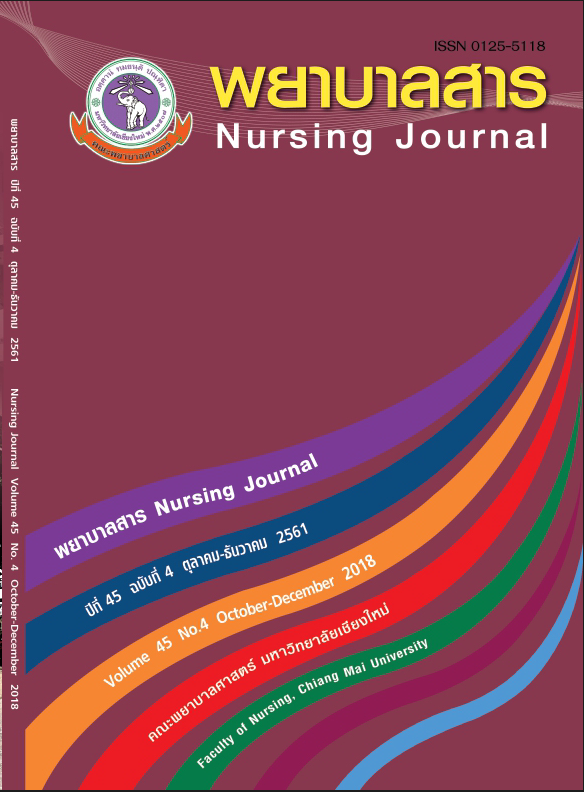The Effect of Maternal Empowerment Program Combined with a Gentletouch on Behavior Response of Low Birth Weight Newborn
Keywords:
low birth weight newborn, response behavior of low birth weight newborn, maternal empowerment program combined with gentle human touch program, normal nursing programAbstract
Low birth weight neonates are risky to problems in response behavior due to lack of continuous sensory stimulation from mother. This Quasi experimental design, interrupted time series with non-equivalence control-group design. Aimed at comparing the responding behavior of low birth weight neonates of first time mothers between experimental group receiving the maternal empowerment program combined with gentle human touch and the control group received normal nursing care. 44 low birth weight newborn babies of first time mothers hospitalized in high risk ward, Police General Hospital 22 babies in experimental and control group equally. The research instruments used were the maternal empowerment program combined with gentle human touch, and the data collection instruments used were the maternal empower scale and neonatal assessment coding sheet. All instruments were tested for content validity by experts. The data were analyzed using descriptive statistics and two-way repeated measure ANOVA. The results revealed that:
1. Neonate’s sleeping and waking up stage: Neonatal in experimental group had differences in Quiet sleep, Drowsy, Awake alert, Active awake and Crying, but no different in active sleep at .05 statistical significance.
2. Neonate’s motor activity categories: Neonatal in experimental group had differences in Behavioral distress cues, No movement and Smiles, but no different in Motor Activity at .05 statistical significance.
References
Ardura, J., Andrés, J., Aldana, J., & Revilla, M. A. (1995). Development of sleep–wakefulness rhythm in premature babies. Acta Pædiatrica, 84(5), 484-489.
Brazelton, T.B. (2013). Understanding the Baby's Language[Online]. Available from: http://www.brazelton institute.com/intro.html[2016,Mar 10]
Burns, N., and Grove, S. K. (2009).The Practice of Nursing Research: Appraisal, synthesis, and generation of evidence,Six edition. St. Louis, Missouri: Saunders.
Hinsil, J. (2006). Maternal participation in caring for high-risk neonates. Master’s Thesis, Pediatric Nursing, Graduate School, Chiang Mai University.
Garcia, A., P. & White-Traut, R., C. (1993). “Preterm infants’ responses to taste/smell and tactile stimulation during an apneic episode”. Journal of Pediatric Nursing, 8, 245- 252.
Gardner, F., & Shaw, D. S. (2009). Behavioral Problems of Infancy and Preschool Children (0–5) Rutter's Child and Adolescent Psychiatry (pp. 882-893): Blackwell Publishing Ltd.
Gibson, C. H. (1995). The process of empowerment in mothers of chronically ill children. Journal of Advanced Nursing, 21(6), 1201-1210. doi: 10.1046/j.1365-2648.1995.21061201.x
Harrison, L. L. (2004). Touch And Massage In Early Child Development: USA.
Harrison, L. L., Leeper, J. D., & Yoon, M. (1990). Effects of early parent touch on preterm infants’ heart rates and arterial oxygen saturation levels. Journal of Advanced Nursing, 15(8), 877-885. doi: 10.1111/j.1365-2648.1990.tb01942.x
Im, H., Kim, E., & Cain, K. C. (2015).Acute effects of Yokson and Gentle Human Touch on the behavioral state of preterm infants. jounals Permissions.nav, 13(3), 212-226.
Jones, N. A., & Mize, K. D. (2007). Low-Cost Approaches to Promote Physical and Mental Health: Johnson & Johnson Pediatric Institute, L.L.C.
Kansiri, S. (2550). Develop a clinical nursing practice guideline (CNPG) for Empowerment Model for Mother of Premature-Infant. Master of Nursing Science in Community Nurse Practitioner, Faculty of Nursing, Thammasat University.
March of Dimes. (2003). Infant Behavior, Reflexes and Cues[Online]. Available from:https://www.marchofdimes.org/nursing/modnemedia/othermedia/infantBehavior.pdf
Modrcin-McCarthy, M. (1992). The physiological and behavioral effects of a gentle human touch nursing intervention on preterm infants (Order No. 9319218). Available from ProQuest Dissertations & Theses Global; ProQuest Nursing &Allied Health Source. (304027307). Retrieved from http://search.proquest.com/docview/304027307?accountid=15637
Modrcin-Talbott, M. A., Harrison, L. L., Groer, M. W., & Younger, M. S. (2003). The Biobehavioral Effects of Gentle Human Touch on Preterm Infants. Nursing Science Quarterly, 16(1), 60-67.
Paehsakun, C., & Thanattheerakul, C. (2010). Maternal Participation in Caring for High-Risk Neonate. The Journal of Boromarajonani College of Nursing, Nakhonratchasima, 16(1), 39-49.
Pakanta, I. (2007). Sleep Problems and Interventions. Journal of Nursing Science Naresuan University. 1(2), 31-38.
Teerarungsikul, N. (2003). Nursing care for premature infants. Bangkok: P. Press Co.,LTD.
Schenk, L. K., Kelley, J. H., & Schenk, M. P. (2005). Family matters. Models of maternal-infant attachment: a role for nurses. Pediatric Nursing, 31(6), 514-517 514p.
Smith, J. R. (2012). Comforting Touch in the Very Preterm Hospitalized Infant: An Integrative Review. Advances in Neonatal Care, 12(6), 349-365.
Downloads
Published
How to Cite
Issue
Section
License
บทความที่ได้รับการตีพิมพ์เป็นลิขสิทธิ์ของวารสารพยาบาลสาร
ข้อความที่ปรากฏในบทความแต่ละเรื่องในวารสารวิชาการเล่มนี้เป็นความคิดเห็นส่วนตัวของผู้เขียนแต่ละท่านไม่เกี่ยวข้องกับมหาวิทยาลัยเชียงใหม่ และคณาจารย์ท่านอื่นๆในมหาวิทยาลัยฯ แต่อย่างใด ความรับผิดชอบองค์ประกอบทั้งหมดของบทความแต่ละเรื่องเป็นของผู้เขียนแต่ละท่าน หากมีความผิดพลาดใด ๆ ผู้เขียนแต่ละท่านจะรับผิดชอบบทความของตนเองแต่ผู้เดียว






